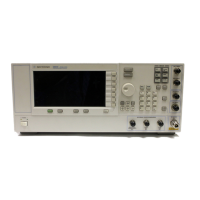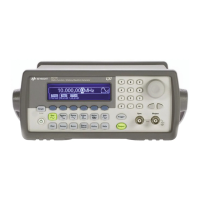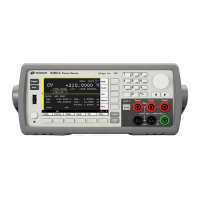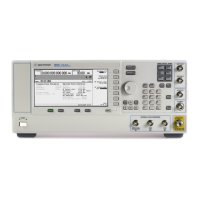E8257D/67D, E8663D PSG Signal Generators Service Guide 137
Troubleshooting
Overall Description
Highband Path – Frequencies 3.2 GHz and Above
The output of the YIG oscillator (3.2 to 10 GHz) is routed to the A29 20 GHz
Doubler microcircuit. Depending on the desired output frequency, the signal is
routed either through a bypass circuit (for frequencies below 10 GHz), or
through a frequency doubler circuit (for frequencies above 10 GHz). After the
bypass or doubler circuits, the signal is amplified and filtered.
In analog models, the A29 20 GHz Doubler output is routed to the A30
Modulation Filter. The A30 contains amplitude and pulse modulators,
amplifiers, and filters. In 40 GHz analog models, the A30 Modulation Filter
output is routed to the doubler path of the A27 40 GHz Doubler for frequencies
above 20 GHz, and to a bypass switch in the A27 40 GHz Doubler for
frequencies up to 20 GHz. The output of the A27 40 GHz Doubler is connected
to the A24 Highband Coupler and A25 Highband Detector, the optional AT1
attenuator, and the front panel RF output connector.
In analog models with output frequencies above 40 GHz, the A30 Modulator
filter provides outputs for the two A36 Quadraplier inputs. One input is to a
bypass circuit for frequencies from 250 kHz to 20 GHz. The other input takes a
10 to 20 GHz signal and doubles it to provide 20 to 40 GHz to a second doubler
for frequencies above 40 GHz. The A36 Quadraplier’s output then connects to
the A24 Highband Coupler and A25 Highband Detector, to the optional AT1
attenuator, and to the front panel RF output connector.
In vector models, the 20 GHz Doubler output is routed to the A35 3–20 GHz
I/Q Modulator and then to the A30 Modulation Filter. The A35 3–20 GHz I/Q
Modulator contains I and Q modulation circuits used to transfer I/Q information
to the RF signal.
> 3.2 GHz 3.2 to 10 GHz Highband path On all models, the 3.2 to 10 GHz oscillator output is doubled to achieve
frequencies between 10 and 20 GHz.
On analog models, the 10 to 20 GHz signal is doubled to achieve
frequencies between 20 and 40 GHz.
On vector models, frequencies between 20 and 44 GHz are developed
using a 40 GHz doubler and an upconverter. The 10 to 20 GHz signal from
the 20 GHz Doubler is doubled using the same 40 GHz Doubler used in
analog models, and then used as the LO input to the A37 Upconverter. A
3.2 to 10 GHz signal from the 20 GHz Doubler is fed to the IQ side of the
A37 Upconverter. Frequencies up to <28.5 GHz are the difference
between the LO and IQ inputs to the upconverter and frequencies 28.5
GHz to 44GHz are the sum.
In analog models with output frequencies >40 GHz, the output frequency
is developed by replacing the A27 40 GHz Doubler with the
A36 Quadraplier. The A36 Quadraplier doubles the 10 to 20 GHz signal to
develop frequencies up to 40 GHz and then doubles >20 GHz signals to
generate frequencies >40 GHz.
Output
Frequency
Oscillator
Frequency
Path Notes

